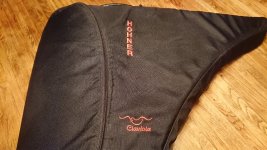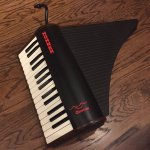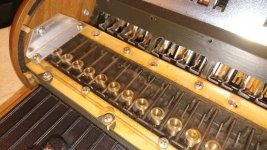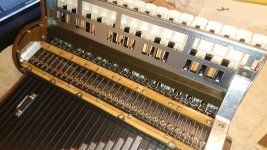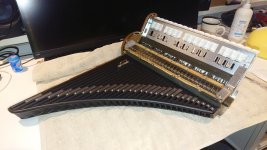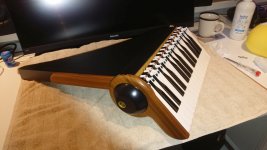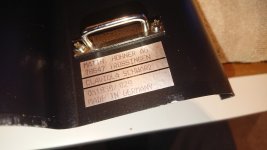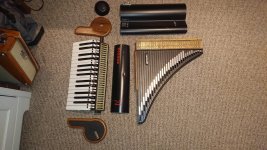You are using an out of date browser. It may not display this or other websites correctly.
You should upgrade or use an alternative browser.
You should upgrade or use an alternative browser.
christmas came early! (Hohner Claviola project)
- Thread starter jozz
- Start date
- Status
- Not open for further replies.
Corinto
Well-known member
Congrats!
Dingo40
Been here for ages!
What is that??
Dingo40
Been here for ages!
Thanks Jerry,
Here's more about it:?
Happy playing, Jozz!??
Here's more about it:?
Happy playing, Jozz!??
Mr Mark
Squeezebaggeroni...
Learn some new reeds everyday...those sound pretty swell on youtube, nice prezzie!
Both the air chamber and the underside of the reeds, against the pipes, have a gasket. The one against the pipes I nearly tore, because it sits against the wax of the reeds. Luckily it's a rubbery flex piece.
Anyone reading this and doing the same: be careful!
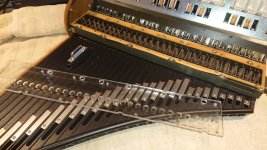
Plexiglass sealing the air chamber comes 'easily' of it's gasket. Be sure to keep your arm on it when removing the last bolts, because the springs are loaded.
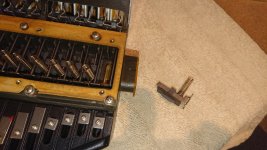
To help you with that, the springs are clamped on the valve assembly. This piece sits completely free in the slot.
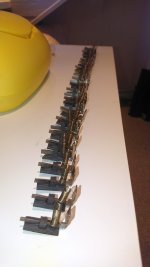
All valve parts out of the air chamber and lined up.
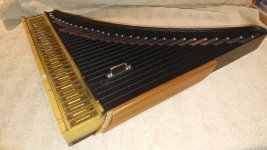
Keyboard assembly removed from the pipes 'block'. This piece is a massive block of plastic and has a black powdery coating that seems strike resistance. The wood piece is glued to the 'block'.
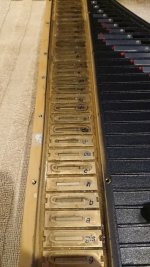
Reeds waxed into place on the pipes. They sit above a slot running straight down into the base of each pipe. Once assembled, on top of the reeds sits a rubbery gasket that stays in the keyboard assembly.
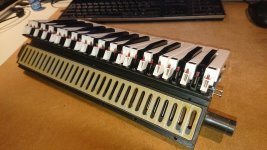
Keyboard assembly. Here you see the gasket and you can look straight through into what normally would be the air chamber. On the right side is the air intake, where the mouth piece goes into.
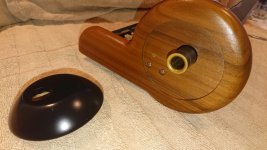
The top piece only comes off once all screws on the inside are removed, the biggest one inside is retaining the black cover piece. Once the cover is gone, you can undo the two bolts here visible next to the air intake, then the wood piece slides off the air intake.
Now to cleanup and put back together!
Anyone reading this and doing the same: be careful!

Plexiglass sealing the air chamber comes 'easily' of it's gasket. Be sure to keep your arm on it when removing the last bolts, because the springs are loaded.

To help you with that, the springs are clamped on the valve assembly. This piece sits completely free in the slot.

All valve parts out of the air chamber and lined up.

Keyboard assembly removed from the pipes 'block'. This piece is a massive block of plastic and has a black powdery coating that seems strike resistance. The wood piece is glued to the 'block'.

Reeds waxed into place on the pipes. They sit above a slot running straight down into the base of each pipe. Once assembled, on top of the reeds sits a rubbery gasket that stays in the keyboard assembly.

Keyboard assembly. Here you see the gasket and you can look straight through into what normally would be the air chamber. On the right side is the air intake, where the mouth piece goes into.

The top piece only comes off once all screws on the inside are removed, the biggest one inside is retaining the black cover piece. Once the cover is gone, you can undo the two bolts here visible next to the air intake, then the wood piece slides off the air intake.
Now to cleanup and put back together!
Example audio after cleaning
(at first 5 or 6 reeds were sounding at once because I hadn't seated them properly)
thankfully, now it works, and feels quite airtight too
second part I try to wahwah the sound with my hand at the end of the pipes, kind of difficult as you have to guess which pipe you're currently playing, and move along
JeffJetton
Prolific poster
Thanks Jerry,
Here's more about it:?
Happy playing, Jozz!??
Hey that's fellow Nashvillian Rory Hoffman!
Thanks Jerry,
Here's more about it:?
Happy playing, Jozz!??
OK, I was sincerely surprised and impressed with that sound... totally not what I was expecting... Joss, that's an amazing new instrument you have there!!
Dent removal
After an hour with a heatgun and a round plastic hairbrush from my daughter, I was able to reduce the obvious dent at the front a bit.
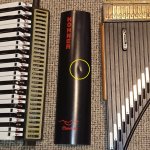
Before

After
Next: the chipped wood at the top...
I guess I have to glue in a piece. Any tips on what kind of wood these endcaps are made of?That video of Rory's shows the caps a tad darker than mine. I suppose this is either stained or different kind of wood. Mine don't look really stained, as the cutting surfaces of the milling on the inside, and the inside of the broken off bit, is much the same color as the outside.
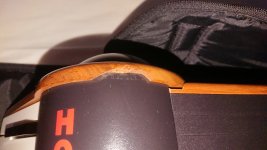
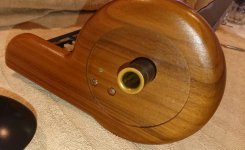
Last edited:
Here is a little more info about Claviolas.
(Scroll down.) Lists some players.
Short discussion of reeds.
 Method book? (I don't speak German.)
Method book? (I don't speak German.)
(Scroll down.) Lists some players.
Short discussion of reeds.

Claviola spielen Das neue Blasinstrument für Jedermann. Anleitung für das Spiel | eBay
Find many great new & used options and get the best deals for Claviola spielen Das neue Blasinstrument für Jedermann. Anleitung für das Spiel at the best online prices at eBay! Free shipping for many products!
www.ebay.com
Last edited:
Just by the inside colour my completely uneducated guess would be mahogany.Before
After
Next: the chipped wood at the top...
I guess I have to glue in a piece. Any tips on what kind of wood these endcaps are made of?
That video of Rory's shows the caps a tad darker than mine. I suppose this is either stained or different kind of wood. Mine don't look really stained, as the cutting surfaces of the milling on the inside, and the inside of the broken off bit, is much the same color as the outside.

Another one.
Dingo40
Been here for ages!
Chris,
Thanks for sharing this clip: comprehensive!??
Thanks for sharing this clip: comprehensive!??
JeffJetton
Prolific poster
Method book? (I don't speak German.)
Claviola spielen Das neue Blasinstrument für Jedermann. Anleitung für das Spiel | eBay
Find many great new & used options and get the best deals for Claviola spielen Das neue Blasinstrument für Jedermann. Anleitung für das Spiel at the best online prices at eBay! Free shipping for many products!www.ebay.com
I know a little German. (Cue "Top Secret" reference.)
Looks like a method book. I think it says:
Play Claviola
The new instrument for everyone
Instructions for playing alone and in groups
my guess too, although i thought about stained douglas fir as well, because of the pink en the contrasting line patternJust by the inside colour my completely uneducated guess would be mahogany.
Another one.
Surely this is the same one Jozz bought?. It already has the dent.
- Status
- Not open for further replies.
Similar threads
- Replies
- 11
- Views
- 330

